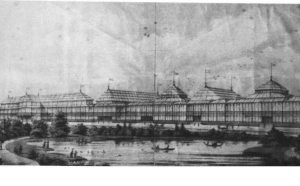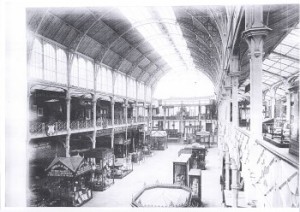Almost everyone has heard of the Crystal Palace. The better informed would tell you that it was the inspiration of Victoria’s German husband, Prince Albert, as a place designed to hold the Great Exhibition of 1851. They would maybe add that it was later moved to Sydenham in south east London to a site on a ridge and that the village that grew up around the building took the building’s name as its own.
 Few could ever guess that there was once another such a giant greenhouse situated a mere penny tram ride across Chelsea Bridge from Sloane Square. Photographs are elusive, but this is an engraving.
Few could ever guess that there was once another such a giant greenhouse situated a mere penny tram ride across Chelsea Bridge from Sloane Square. Photographs are elusive, but this is an engraving.
And the reason why so few would know of the existence of this huge glass and cast iron structure that took three years to build is because it lasted less than one summer. Opened in May 1885, by September the receiver was called in to close down the company. The structure hung around for nearly ten years as a sort of protected species in a Victorian chapter 11 status, while the various factions among the creditors fought to protect their interests.
If the Albert Palace existed today it would easily rival the Albert Hall or Nelson’s Column as an intrinsic, iconic image of London. But Google it now and you’re lucky to get just one hit, with a vague sentence or two about its existence, nothing more.
![x17[1]](http://actonbooks.files.wordpress.com/2014/07/x171.gif?w=300) The fate of the Albert Palace was predicted by the money men and the regulators. They could see that it was hugely underfunded. However, it wasn’t an outcome that the building’s architects would have contemplated in their wildest dreams. This is especially so because when they built it, the nearest river to the building was not the Thames, but the Liffey. The building’s birthplace was not in London at all, but in the centre of Dublin.
The fate of the Albert Palace was predicted by the money men and the regulators. They could see that it was hugely underfunded. However, it wasn’t an outcome that the building’s architects would have contemplated in their wildest dreams. This is especially so because when they built it, the nearest river to the building was not the Thames, but the Liffey. The building’s birthplace was not in London at all, but in the centre of Dublin.
It had been put up 20 years earlier to house Ireland’s own version of the Great Exhibition. A passion for such events was sweeping across Europe and the US, following the undoubted acclaim (and the large amounts of money for good works), generated from the Crystal Palace.
But even in Dublin the Dublin Exhibition Palace, as it was then called, was mired in controversy from the outset. The design was decided in an architectural contest that many among the Dublin architectural community thought was rigged. The building housed two national exhibitions, separated by nearly a decade. Each brought financial disaster upon its backer. Eventually the edifice fell into the hands of the Guinness family, who  raised the distaste of Dublin society when they sold it after losing money on their own Dublin show.
raised the distaste of Dublin society when they sold it after losing money on their own Dublin show.
As folk had already discovered from the Crystal Palace experience, one of the joys of the iron girder and glazed construction was that such buildings were quick and easy to put up, but more interestingly, they were quick and easy and cheap to take down, transport and put up somewhere else. It was unbolted in Dublin, crated and arrived in London to be reconstructed on a thin sliver of land just outside Battersea Park and finally opened its doors again –briefly — in 1885.  Following after the original failed consortium, the site slid downmarket as a succession of populist promoters tried to make a go of it. After hosting circuses, wild west shows, bicycle races and bonniest baby competitions, a page from the final auction catalogue shows it reduced to so many tons of cast and wrought iron.
Following after the original failed consortium, the site slid downmarket as a succession of populist promoters tried to make a go of it. After hosting circuses, wild west shows, bicycle races and bonniest baby competitions, a page from the final auction catalogue shows it reduced to so many tons of cast and wrought iron.

Fascinating.
I only discovered it because I used to live in the block of flats that replaced it
I found out a lot of fascinating stuff about Crystal Palace a year or two ago – really enjoyed all the detail. Was completely unaware of Albert Palace! Thanks!